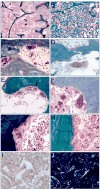Effects of androgen deprivation therapy and bisphosphonate treatment on bone in patients with metastatic castration-resistant prostate cancer: results from the University of Washington Rapid Autopsy Series
- PMID: 22936276
- PMCID: PMC3547166
- DOI: 10.1002/jbmr.1749
Effects of androgen deprivation therapy and bisphosphonate treatment on bone in patients with metastatic castration-resistant prostate cancer: results from the University of Washington Rapid Autopsy Series
Abstract
Qualitative and quantitative bone features were determined in nondecalcified and decalcified bone from 20 predetermined bone sites in each of 44 patients who died with castration-resistant prostate cancer (CRPC), some of which received bisphosphonate treatment (BP) in addition to androgen-deprivation therapy (ADT). Thirty-nine of the 44 patients (89%) had evidence of bone metastases. By histomorphometric analysis, these bone metastases were associated with a range of bone responses from osteoblastic to osteolytic with a wide spectrum of bone responses often seen within an individual patient. Overall, the average bone volume/tissue volume (BV/TV) was 25.7%, confirming the characteristic association of an osteoblastic response to prostate cancer bone metastasis when compared with the normal age-matched weighted mean BV/TV of 14.7%. The observed new bone formation was essentially woven bone, and this was a localized event. In comparing BV/TV at metastatic sites between patients who had received BP treatment and those who had not, there was a significant difference (28.6% versus 19.3%, respectively). At bone sites that were not invaded by tumor, the average BV/TV was 10.1%, indicating significant bone loss owing to ADT that was not improved (11%) in those patients who had received BPs. Surprisingly, there was no significant difference in the number of osteoclasts present at the metastatic sites between patients treated or not treated with BPs, but in bone sites where the patient had been treated with BPs, giant osteoclasts were observed. Overall, 873 paraffin-embedded specimens and 661 methylmethacrylate-embedded specimens were analyzed. Our results indicate that in CRPC patients, ADT induces serious bone loss even in patients treated with BP. Furthermore, in this cohort of patients, BP treatment increased BV and did not decrease the number of osteoclasts in prostate cancer bone metastases compared with bone metastases from patients who did not receive BP.
Copyright © 2013 American Society for Bone and Mineral Research.
Figures



References
-
- Bubendorf L, Schopfer A, Wagner U, Sauter G, Moch H, Willi N, Gasser TC, Mihatsch MJ. Metastatic patterns of prostate cancer: an autopsy study of 1,589 patients. Hum Pathol. 2000;31:578–583. - PubMed
-
- Lange PH, Vessella RL. Mechanisms, hypotheses and questions regarding prostate cancer micrometastases to bone. Cancer Metastasis Rev. 1998;17:331–336. - PubMed
-
- Olson KB, Pienta KJ. Pain management in patients with advanced prostate cancer. Oncology (Williston Park) 1999;13:1537–1549. - PubMed
-
- Shahinian VB, Kuo YF, Freeman JL, Goodwin JS. Risk of fracture after androgen deprivation for prostate cancer. N Engl J Med. 2005 Jan 13;352:154–164. - PubMed
Publication types
MeSH terms
Substances
Grants and funding
LinkOut - more resources
Full Text Sources
Other Literature Sources
Medical

